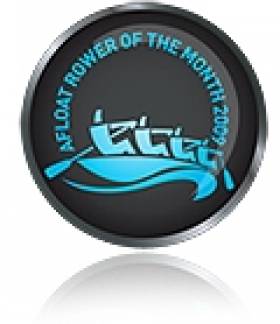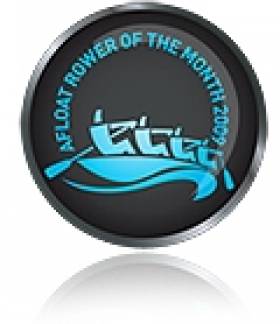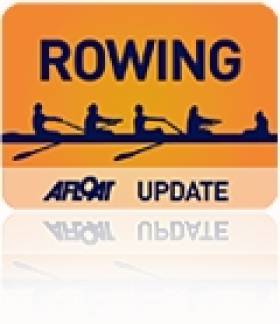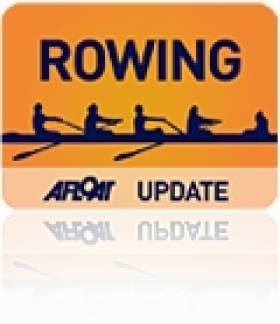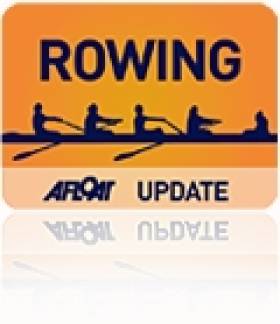Displaying items by tag: Aiguebelette
Afloat Rowers of the Year Announced
#Rowing: The Afloat Rowers of the Year for 2015 are the Ireland men’s and women’s lightweight double sculls who qualified their boats for the Olympic Games in 2016.
Claire Lambe and Sinéad Jennings needed to finish in the top 11 at the World Championships in Aiguebelette in August/September. They seemed well-placed in their semi-final to qualify for the A Final, but were pushed into fourth as Canada finished with a remarkable sprint. The Ireland crew changed tactics for the B Final, and it worked. They finished ninth.
The men’s lightweight double of Gary and Paul O’Donovan had a similar qualification mark in Aiguebelette. To have a shot they had to finish in the top three in their quarter-final, and they achieved this, pushing Hayden Cohen and Peter Taylor of New Zealand into fourth. They finished fifth in their semi-final and then booked their Rio place with a fifth-place finish (11th overall) in their B Final, eking out a place ahead of Greece, who had finished eighth at the Olympic Games in London.
Afloat wishes both crews and all the Irish rowing community the very best in 2016.
Rower of the Year Award: The judging panel is made up of Liam Gorman, rowing correspondent of The Irish Times and David O'Brien, Editor of Afloat magazine. Monthly awards for achievements during the year appeared on afloat.ie. The overall national award has been given to the crews who, in the judges' opinion, achieved the most notable results and made the most significant contribution to rowing during 2015. Keep an eye on progress in 2016.
Puspure So Close To Olympic Qualification at Aiguebelette
#Rowing: Sanita Puspure came up just short of gaining Olympic qualification for the Ireland single scull in a tight finish of the B Final at the World Championships in Aiguebelette in France this morning. The Old Collegians woman carved out an impressive lead of just over a length after 500 metres and held it until the final quarter. Just three from this race would qualify boats for Rio, and the field caught Puspure coming up to the finish. On the line, Puspure took fifth, .66 of a second behind third-placed Magdalena Lobnig of Austria.
World Rowing Championships, Aiguebelette, France – Day Eight (Irish interest)
Men
Lightweight Four - B Final (Places 7 to 12): 3 Britain (2 P Chambers) 5:56.29.
Single Sculls – B Final (Places 7 to 12): 2 Britain (A Campbell) 6:46.68
Women
Single Sculls – B Final (Places 7 to 12): 1 Sweden 7:26.60, 2 Lithuania 7:27.30, 3 Austria 7:27.52; 4 Belarus 7:27.86, 5 Ireland (S Puspure) 7:28.18, 6 Zimbabwe 7:31.74.
Afloat Rower of the Month is World Rowing Finalist Sanita Puspure
#ROWING: The Afloat Rower of the Month for August is Sanita Puspure. The Old Collegians oarswoman took fourth place at the World Rowing Championships in Amsterdam in the single sculls, just outside the medals in this elite discipline. She had won her heat, placed second in the quarter-final and third in a semi-final where conditions were very difficult.
The performance topped off an outstanding season for this gritty competitor. She started her run with silver medals on both days of the Memorial Paolo d’Aloja regatta in Italy in April. She took a bronze medal at the European Championships – a breakthrough for an Ireland heavyweight woman – and then made the A Final at the World Cup regatta in Aiguebelette, and won the B Final at Lucerne.
Rower of the Month awards: The judging panel is made up of Liam Gorman, rowing correspondent of The Irish Times and David O'Brien, Editor of Afloat magazine. Monthly awards for achievements during the year will appear on afloat.ie and the overall national award will be presented to the person or crew who, in the judges' opinion, achieved the most notable results in, or made the most significant contribution to rowing during 2014. Keep a monthly eye on progress and watch our 2014 champions list grow.
Puspure Takes Second Successive Rower of the Month Award
#ROWING: The Rower of the Month for June is Sanita Puspure. The single sculler from the Old Collegians club won her place in the A Final of the World Cup at Aiguebelette in France, where she finished sixth. It was confirmation that the Latvian-born competitor who now lives in Cork has established herself in this demanding discipline. She will compete in the final World Cup of the season, in Lucerne in Switzerland, next weekend.
The Ireland Olympian wins the award for the second successive month, having also taken it in May, when she took bronze at the European Championships.
Rower of the Month awards: The judging panel is made up of Liam Gorman, rowing correspondent of The Irish Times and David O'Brien, Editor of Afloat magazine. Monthly awards for achievements during the year will appear on afloat.ie and the overall national award will be presented to the person or crew who, in the judges' opinion, achieved the most notable results in, or made the most significant contribution to rowing during 2014. Keep a monthly eye on progress and watch our 2014 champions list grow.
O'Donovan Bosses B Final at World Cup Rowing Regatta
#ROWING: Paul O’Donovan won the B Final of the lightweight single sculls at the World Cup Regatta in Aiguebelette in France this morning. The UCD man was fourth at 500 metres but headed the field in the final quarter and moved clear to win well and secure seventh overall.
The women’s pair of Leonora Kennedy and Lisa Dilleen finished third in their B Final, ninth overall. New Zealand’s Louise Trappitt and Rebecca Scown – who won the A Final at the first World Cup in Sydney – were impressive winners of this race, while Ireland and Canada battled for second, well ahead of Germany One, Britain Two and France.
The Ireland lightweight women’s double scull of Claire Lambe and Denise Walsh finished their first regatta together as a crew fifth in the B Final, 11th overall. China Two won from the United States, Australia and Denmark while behind them Ireland outpaced Brazil all the way down the course.
World Cup Regatta, Aiguebelette, France, Day Three (Irish interest, selected results)
Men
Lightweight Single Sculls – B Final (Places 7 to 12): 1 Ireland One (P O’Donovan) 7:07.46, 2 Azerbaijan (J Afandiyev) 7:08.23, 3 Britain (Z Lee-Green) 7:10.55, 4 France 7:13.96, 5 Algeria 7:17.64, 6 Switzerland 7:19.68.
Women
Pair – B Final (Places 7 to 12): 1 New Zealand (L Trappitt, R Scown) 7:10.55, 2 Canada (N Mastracci, S Grainger) 7:15.16, 3 Ireland (L Kennedy, L Dilleen) 7:16.53, 4 Germany 7:24.64, 5 Britain 7:26.55, 6 France 7:27.64.
Lightweight Double Scull – B Final (Places 7 to 12): 1 China Two (Huan Zhang, Le Chen) 7:11.20, 2 United States (D Karz, M Sechser) 7:12.17, 3 Australia (E Flecker, A McNamara) 7:13.42, 4 Denmark 7:14.02, 5 Ireland (C Lambe, D Walsh) 7:16.71, 6 Brazil 7:23.33.
,
In-Form Puspure Makes Second Successive Championship Final
#ROWING: Ireland’s Sanita Puspure qualified for her second successive championship final by finishing third in her semi-final at the World Cup regatta in Aiguebelette in France. Emma Twigg of New Zealand, who won gold at the first World Cup regatta in Sydney, won this sem-final convincingly, with Genevra Stone of the United States and Puspure taking the other A Final qualification spots. Puspure started well and led early on. When Stone came through she and Stone swapped second and third, staying clear of the rest of the field.
World Cup Regatta, Aiguebelette, France, Day Two (Selected Results, Irish interest)
Men
Single Sculls – D Final (Places 19 to 23): 1 Bulgaria 7:14.01, 2 Ireland (J Keohane) 7:16.48, 3 China 7:19.41.
Lightweight Single Sculls – Semi-Final Two (First Three to A Final; rest to B Final): 1 Germany Two (J Schoemann-Finck) 7:00.71, 2 Bulgaria (V Nedelcho) 7:03.69, 3 France (D Piqueras) 7:04.23; 4 Ireland One (P O’Donovan) 7:06.99, 5 Switzerland One 7:14.8, 6 Algeria 7:21.36. C Final (places 13 to 18): 1 Ireland Two (M O’Donovan) 7:17.11, 2 Tunisia One 7:17.40, 3 Switzerland Two 7:19.58.
Women
Pair – A/B Semi-Final One (First Three to A Final; rest to B Final):
1 United States Three (V Opitz, M Musnicki) 7:02.27, 2 United States One (M Kalmoe, K Simmonds) 7:02.33, 3 United States Four (A Polk, L Schmetterling) 7:04.23; 4 Canada 7:07.94, 5 Ireland (L Kennedy, L Dilleen) 7:16.80, 6 France 7:32.46.
Double Sculls – C Final (Places 13, 14): 1 France 7:12.84, 2 Ireland (M Dukarska, E Moran) 7:20.78.
Lightweight Double Sculls – A/B Semi-Final One (First Three to A Final; rest to B Final): 1 Britain (I Walsh, K Copeland) 7:05.84, 2 China One (Tianyu Teng, Wenyi Huang) 7:07.25, 3 Sweden (C Lilja, E Fredh) 7:08.90; 4 Australia 7:13.07, 5 China Two 7:13.17, 6 Ireland (C Lambe, D Walsh) 7:14.79.
Single Sculls – A/G Semi-Final Two (First Three to A Final; rest to B Final): 1 New Zeland (E Twigg) 7:27.30, 2 United States (G Stone) 7:33.02, 3 Ireland (S Puspure) 7:33.79; 4 Germany 7:38.42, 5 Switzerland 7:42.76, 6 France 7:44.20
Pararowing: ASM1X - B Final: 4 Ireland (T Kelly) 5:42.41.
Dilleen and Kennedy Fall to United States Rowing Invasion
#ROWING: Ireland’s Lisa Dilleen and Leonora Kennedy finished fifth in the pairs’ semi-final at the World Cup Regatta in Aiguebelette today. Three United States crews drawn from their eight took the qualification spots with Canada – also a crew drawn from the country’s eight – fourth. Dilleen and Kennedy tried to break into the dominant leading group but could not.
The lightweight women’s double of Claire Lambe and Denise Walsh stuck gamely to their task in their semi-final, but finished sixth. China One, Sweden and Britain’s Kat Copeland and Imogen Walsh collared the three qualification spots, with Copeland and Walsh judging their finish well to win.
World Cup Regatta, Aiguebelette, France, Day Two (Selected Results, Irish interest)
Men
Single Sculls – D Final (Places 19 to 23): 1 Bulgaria 7:14.01, 2 Ireland (J Keohane) 7:16.48, 3 China 7:19.41.
Lightweight Single Sculls – Semi-Final Two (First Three to A Final; rest to B Final): 1 Germany Two (J Schoemann-Finck) 7:00.71, 2 Bulgaria (V Nedelcho) 7:03.69, 3 France (D Piqueras) 7:04.23; 4 Ireland One (P O’Donovan) 7:06.99, 5 Switzerland One 7:14.8, 6 Algeria 7:21.36. C Final (places 13 to 18): 1 Ireland Two (M O’Donovan) 7:17.11, 2 Tunisia One 7:17.40, 3 Switzerland Two 7:19.58.
Women
Pair – A/B Semi-Final One (First Three to A Final; rest to B Final):
1 United States Three (V Opitz, M Musnicki) 7:02.27, 2 United States One (M Kalmoe, K Simmonds) 7:02.33, 3 United States Four (A Polk, L Schmetterling) 7:04.23; 4 Canada 7:07.94, 5 Ireland (L Kennedy, L Dilleen) 7:16.80, 6 France 7:32.46.
Double Sculls – C Final (Places 13, 14): 1 France 7:12.84, 2 Ireland (M Dukarska, E Moran) 7:20.78.
Lightweight Double Sculls – A/B Semi-Final One (First Three to A Final; rest to B Final): 1 Britain (I Walsh, K Copeland) 7:05.84, 2 China One (Tianyu Teng, Wenyi Huang) 7:07.25, 3 Sweden (C Lilja, E Fredh) 7:08.90; 4 Australia 7:13.07, 5 China Two 7:13.17, 6 Ireland (C Lambe, D Walsh) 7:14.79.
Mark O'Donovan Finishes Well at World Cup Rowing
#ROWING: Mark O’Donovan ended his participation at the World Cup Regatta in Aiguebelette on a high today. He was entered in the lightweight single sculls after his lightweight pairs partner Niall Kenny had to pull out, but O’Donovan won the C Final this morning. His remarkable drive to the line took him past Aymen Mejri of Tunisia, who had dominated the race to that point. The win placed O’Donovan 13th overall.
The women’s double of Monika Dukarska and Eimear Moran finished second in their C Final, 14th overall and John Keohane in the the same position in the D Final of the open single sculls, 20th overall.
World Cup Regatta, Aiguebelette, France, Day Two (Selected Results, Irish interest)
Men
Single Sculls – D Final (Places 19 to 23): 1 Bulgaria 7:14.01, 2 Ireland (J Keohane) 7:16.48, 3 China 7:19.41.
Lightweight Single Sculls – Semi-Final Two (First Three to A Final; rest to B Final): 1 Germany Two (J Schoemann-Finck) 7:00.71, 2 Bulgaria (V Nedelcho) 7:03.69, 3 France (D Piqueras) 7:04.23; 4 Ireland One (P O’Donovan) 7:06.99, 5 Switzerland One 7:14.8, 6 Algeria 7:21.36. C Final (places 13 to 18): 1 Ireland Two (M O’Donovan) 7:17.11, 2 Tunisia One 7:17.40, 3 Switzerland Two 7:19.58.
Women
Double Sculls – C Final (Places 13, 14): 1 France 7:12.84, 2 Ireland (M Dukarska, E Moran) 7:20.78.
#ROWING: Paul O’Donovan finished fourth in the A/B semi-final of the lightweight single sculls at the World Cup in Aiguebelette this morning and will compete in tomorrow’s B Final. The UCD man was fourth at halfway and made a big push in the third quarter, but could not secure a place in the top three.
World Cup Regatta, Aiguebelette, France, Day Two (Selected Results, Irish interest)
Men
Lightweight Single Sculls – Semi-Final Two (First Three to A Final; rest to B Final): 1 Germany Two (J Schoemann-Finck) 7:00.71, 2 Bulgaria (V Nedelcho) 7:03.69, 3 France (D Piqueras) 7:04.23; 4 Ireland One (P O’Donovan) 7:06.99, 5 Switzerland One 7:14.8, 6 Algeria 7:21.36.
Moran and Dukarska Miss out at Aiguebelette Rowing
#ROWING: Ireland’s Monika Dukarska and Eimear Moran had to settle for missing out on a semi-final place at the World Cup Regatta in Aiguebelette in France. The Ireland double scull was in with a chance of taking the top-three place they needed until the final third of the race. John Keohane was off the pace in his repechage of the men’s single scull.The Corkman finished fourth when a top-two place would have taken him through to the A/B semi-finals.
World Cup Regatta, Aiguebelette, France, Day One (Selected Results, Irish interest)
Men
Single Sculls – Heat One (Time Trial; First Directly to A/B Semi-Finals; rest to Repechage); 1 Cuba (A Fournier Rodriguez) 6:48.06; 2 Canada 6:55.45, 3 Finland 6:59.39, 4 United States 7:06.59, 5 Ireland (J Keohane) 7:12.69, 6 Hungary 7:17.37. Repechage One (Two to A/B Semi-Finals): 4 Keohane 7:39.38.
Lightweight Single Sculls – Heats (Time Trials; First Two Directly Through to A/B Semi-Finals; rest to Repechage) – Heat One: 1 China (Tiexin Wang) 7:02.36, 2 France (D Piqueras) 7:07.64; 5 Ireland Two (M O’Donovan) 7:20.78
Heat Three: 1 Ireland One (P O’Donovan) 7:11.34, 2 Britain (Z Lee-Green) 7:15.60.
Repechage One (First Two to A/B Semis; 3-5 to C Final): 4 Ireland Two (O’Donovan) 7:37.56.
Women
Pair – Heat Two (Time Trial; First Three to A/B Semi-Finals; rest to Repechage): 1 Canada (N Mastracci, S Grainger) 7:13.29, 2 United States Two (G Luczak, C Lind) 7:13.87, 3 Ireland (L Kennedy, L Dilleen) 7:18.15; 4 Germany Two 7:32.77, 5 China Two 7:37.06.
Double Sculls – Heat Three (Time Trial; First Three Directly to A/B Semi-Finals; rest to Repechage): 1 Belarus (E Karsten, Y Bichyk) 6:51.94, 2 Britain (F Houghton, V Thornley) 6:54.71, 3 China (Yuwei Wang, Weiwei Zhu) 6:57.09; 4 France 7:07.40, 5 Ireland (M Dukarska, E Moran) 7:12.42. Repechage (Three to A/B Semi-Final): 5 Dukarska, Moran 7:40.13.
Lightweight Double Sculls – Heat Two (Time Trial; First Two Directly to A/B Semi-Finals; rest to Repechage): 1 Britain One (I Walsh, K Copeland) 7:02.44, 2 United States (D Karz, M Sechser) 7:07.21; 3 Ireland (C Lambe, D Walsh) 5:21.89, 4 Mexico Two 7:20.55, 5 Belarus 7:20.95. Repechage (First Two to A/B Semi-Finals; 3-5 to C Final): 1 Brazil (B Cardoso, F Beltrame) 7:24.44, 2 Ireland (Lambe, Walsh) 7:25.65; 3 Poland 7:27.13, 4 Belarus 7:33.59, 5 Czech Republic 7:37.94, 6 Mexico One 7:46.68.
Single Sculls – Heat Three (Time Trial; First Two directly to A/B Semi-Finals; rest to Repechage): 1 China (Jingli Duan) 7:30.54, 2 Ireland (S Puspure) 7:34.63; 3 Switzerland 7:35.99, 4 France 7:37.79, 5 Zimbabwe 7:41.57, 6 Croatia 7:42.46.
Pararowing – Arms and Shoulders Men’s Single Sculls – Heat Two (First to A Final; rest to Repechage): 5 Ireland (T Kelly) 5:48.38. Repechage Two (First two to A Final): 4 Kelly 6:06.18.



























